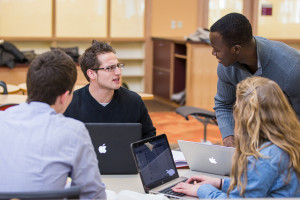Groups and teams are often used in higher education to allow students to see multiple perspectives, to explore their opinions and beliefs, or to deepen understanding. By allowing students to work with each other, they are able to experience multiple viewpoints and more easily change and deepen their ways of thinking about the content at hand. Groups are effective for generating ideas, producing change in outlook, and broadening perspectives.

Challenges of groups and teams
Groups can be formed for just a few minutes or for an entire quarter. When groups are established with a common purpose and mission they are often called a team.
Long-term groups and teams can go through predictable stages, as popularized by Bruce Tuckman’s stages of forming, storming, norming, performing, and adjourning. It can be expected that all groups will experience some difficulties at times, and providing information and guidance to students about these predictable stages can be helpful.
Groups can also suffer from common problems such as conflict, apathy, social loafing, and groupthink. Each of these problems are be solved in different ways, but they all need to be identified, confronted, and addressed with a plan of action. It’s advisable to let students try to work out problem issues themselves, before they bring them to you. Asking students to write up their own group behavior contracts, establish group rules, and create their own policies of managing problems at the beginning of group work can ease this sometimes difficult process.
Another common problem with groups is the unequal division of labor and the resentment that results. Proponents of team based learning (TBL) argue that problems often occur when groups are asked to create a complicated outcome such as a final paper or presentation. This often results in a divide-and-conquer approach, where students learn just an individual component rather than learning more than the sum of the project. With approaches such as TBL, the final outcome for the groups is represented in simple form, such as choosing from a few given options or making a specific choice. The focus of the group work is on the process rather than the product.
Tips for the effective use of groups and teams
- Create groups of appropriate size and scope– a group should have enough members to represent the diversity of opinions, perspectives, or skills needed to complete the task, but small enough for everyone to meaningfully participate.
- Provide an activity or task that produces discussion or encourages collaboration. A task that can easily be completed without collaborating is not a great choice for a group activity.
- Spend some time giving students background on the process of working in a group – help them set rules, expectations, norms, and guidelines.
- Stay involved by setting periodic check-in dates or monitoring the progress of the groups. Help students identify and address common group problems, give them tools to do this by themselves if possible.
- Make sure to debrief or otherwise help students interpret the learning that has occurred.
Tools for group work
- Group project tools from Carnegie Mellon, including sample contracts and self/peer evaluations
- Sample peer and self evaluation questions from Penn State
- Examples of group contracts
- CATME – a suite of free online tool for arranging groups and conducting peer and self evaluations, originally developed for engineering classes.
Resources
- Read some advice shared about facilitating student groups from a recent OTL workshop
- Using group projects effectively from Carnegie Mellon
- Explore specific methods such as cooperative learning or team-based learning
- Defining and Promoting Teamwork in the Classroom
- Designing Effective Group Activities: Lessons for Classroom Teaching and Faculty Development
- Johnson and Johnson’s Overview of Cooperative Learning
- Examples of Basic and Advanced Cooperative Learning Methods
- Turning Student Groups into Effective Teams


